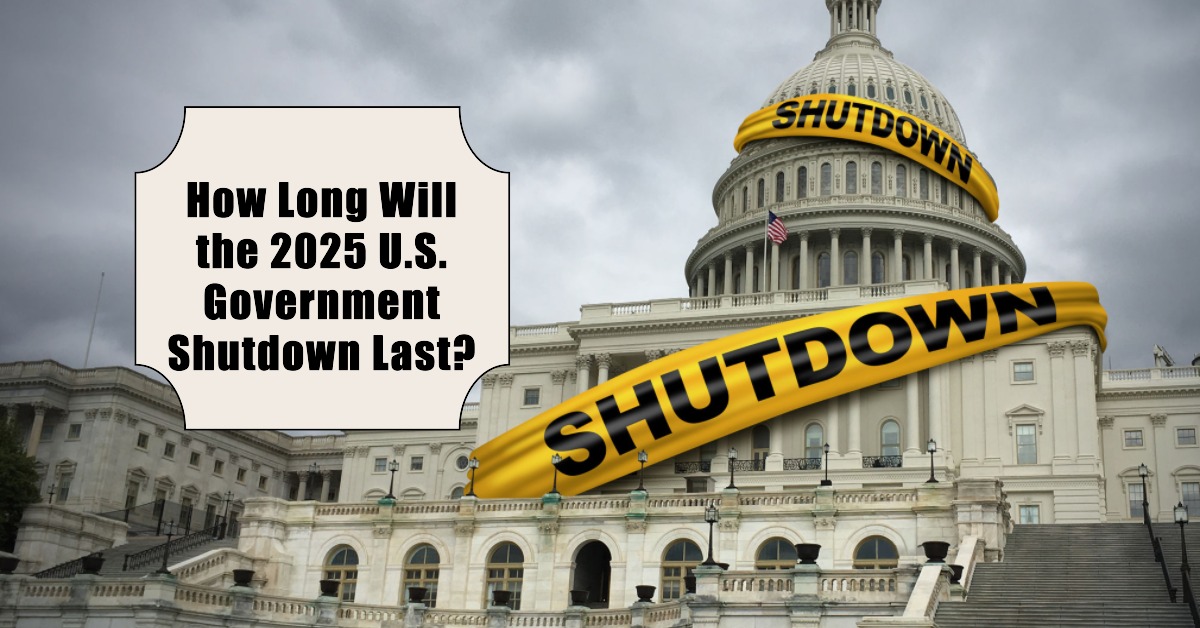Well, here we are again. On October 1, 2025, the U.S. federal government ground to a halt, and the big question on everyone's mind is: how long will this 2025 government shutdown last? Based on what we're seeing and what history tells us, I can give you a definitive answer right now: it’s not going to be quick, but it probably won’t break the record. We're likely looking at a situation that stretches for a while – possibly a couple of weeks – because the issues at play are pretty sticky.
How Long Will the 2025 U.S. Government Shutdown Last?
It feels like Groundhog Day, doesn't it? We’ve seen this movie before. Federal agencies stop non-essential services, workers are furloughed (meaning they’re sent home without pay, at least initially), and essential services continue running, albeit often with a skeleton crew. The uncertainty is what always gets me. People I know who work for the government, or who rely on government services, start to worry. Will their paychecks be delayed? Will that permit they’re waiting for ever come through? Will the national parks they love to visit be accessible?
Let’s be honest, this is more than just a bureaucratic hiccup. It’s a stark reminder of the deep divisions within our government and the tough realities of political negotiation. This isn't just about budgets; it's about priorities and who gets to decide what those priorities are.
The Nitty-Gritty: What's Causing This Shutdown?
So, the clock struck midnight and zilch. No agreement was reached on funding for the new fiscal year, which started on October 1st. Congress couldn’t agree on any of the 12 appropriations bills that fund the government, and crucially, no temporary measure – known as a continuing resolution (CR) – was passed to keep the lights on.
The main sticking point, and it’s a significant one, revolves around healthcare subsidies. Democrats are pushing hard to extend funding for the Affordable Care Act (ACA) subsidies. These subsidies are pretty vital because they help millions of Americans afford their health insurance. Without them, we're talking about premium spikes that could make healthcare unaffordable for many. We're talking potentially 15-20% increases in some areas, which, as you can imagine, is a massive deal for families.
On the other side, Republicans, who control Congress and the White House, are balking. They’re framing it as Democrats holding the government hostage for unrelated demands. They're also pushing back against funding for things like public media (think NPR) and protections for Medicaid, which they argue are not core to keeping the government running.
It's a bit of a role reversal from past shutdowns, where the roles of who was pushing for what were often flipped. Now, Republicans are the ones in charge and facing the pressure, while Democrats are using their leverage in the Senate to push their agenda. This isn't about party politics as usual; it's about leveraging a crisis to achieve specific policy goals.
It’s also worth noting the economic backdrop. Government spending has really ramped up in recent years. Some argue this spending is out of control and needs to be reined in, which is a valid concern. Others point to essential needs, like nutrition programs for families, that could be severely impacted by a prolonged shutdown. This tension between fiscal restraint and societal needs is always present, but it becomes amplified during these crises.
What Does This Mean for You and Me? The Immediate Impacts
When the government shuts down, it’s not just politicians debating. It's real people and real services being affected. We’re talking about roughly 750,000 federal workers being furloughed right off the bat. If this drags on, that number could climb. And while federal workers usually get back pay, that initial period of not receiving a paycheck can be incredibly stressful. I've heard from federal employees who have had to dip into savings, delay bill payments, or even take on extra work to make ends meet during past shutdowns.
The White House has even floated the idea of permanent layoffs, which is a much more serious and potentially damaging tactic than the temporary furloughs we've seen historically. This could have long-term consequences for government operations and employee morale.
Beyond federal workers, the impact ripples out:
- Public Services: National parks, which are often a source of immense joy and recreation for families, can be closed or left unstaffed. This isn't just about aesthetics; it can lead to safety hazards and vandalism. Think about air travel: delays at the FAA, slower processing of passports, and much-needed food inspections grinding to a halt. These might seem like minor inconveniences, but they can have significant consequences, especially if prolonged. And important services like tax refunds from the IRS could be delayed.
- Health and Nutrition: Programs like WIC (Women, Infants, and Children) and SNAP (Supplemental Nutrition Assistance Program) often have some reserves to keep benefits going for a short while. But if the shutdown stretches on, these crucial lifelines for vulnerable populations could be cut off, leading to real hardship. The funding for disease prevention grants also gets stalled, which is worrying, especially with those ACA subsidies in jeopardy.
- The Economy: While the stock market might initially react, it often rebounds if a quick resolution is expected. But a prolonged shutdown can have a real drag on the economy. Think about delays in government data releases, which are critical for businesses and policymakers. The last shutdown cost the U.S. economy billions of dollars.
We're already seeing states step up to fill some gaps, but their resources are limited. This isn't a sustainable solution for a nationwide crisis.
So, When Will the Government Reopen? The Million-Dollar Question.
This is the million-dollar question, and honestly, there’s no crystal ball. Right now, no talks are officially scheduled. This is concerning because it suggests neither side is in a hurry to budge.
However, several factors will likely push for a resolution:
- Public Pressure: Shutdowns tend to make the party perceived as responsible look bad. Democrats might face criticism for prioritizing health care programs that could impact premiums, while Republicans could be blamed if the disruptive effects of widespread furloughs and service delays become too much for the public to bear.
- Economic Pain: As the economic impacts mount – lost wages for workers, delayed businesses, reduced consumer spending – the pressure to end the shutdown will intensify. The daily cost of a shutdown is significant, and that adds up quickly.
- Political Calendar: With elections always on the horizon (even if they seem far off), neither party wants to be seen as the primary cause of government dysfunction for an extended period. However, intense pressure from their respective bases – some demanding fiscal responsibility, others demanding strong social programs – makes compromise difficult.
Prediction markets, like Kalshi, are offering some insights. They aggregate bets from traders, and right now, the average estimate is around 9.5 to 12 days. Some bets are even leaning towards 15 days or more. This suggests that while a quick fix is hoped for, many anticipate a prolonged stalemate. My own take? Based on the entrenched positions and the complexity of the issues, I'd lean towards the 10-to-14-day range, but I wouldn't be shocked if it crept longer, especially if the political incentives to hold firm outweigh the pressure to compromise.
What Exactly Ends a Government Shutdown?
Fundamentally, a government shutdown ends when Congress passes a funding bill and the President signs it into law. There are typically a few ways this happens:
- Continuing Resolution (CR): This is the most common way shutdowns are resolved. A CR is essentially a temporary funding measure that allows government operations to continue at current levels for a set period. It's like hitting a pause button, giving them more time to work out the details of full appropriations. These can range from a few days to several months.
- Full Appropriations Bills: This is the ideal scenario, where Congress passes all 12 individual spending bills for the year. This is rare, especially mid-shutdown, but it means a comprehensive agreement has been reached.
- Omnibus Spending Package: Sometimes, all the appropriations bills are bundled together into one massive bill, known as an “omnibus.” This is often done to force a vote on a large package that includes provisions from both parties.
- A Compromise Deal: This involves a specific agreement to address the core issues that caused the shutdown. In this case, it might involve some form of extension or negotiation around the ACA subsidies.
Historically, shutdowns often end when one side blinks or when the political or economic pain becomes too great to bear. Think about the 1995-1996 shutdown, which ended partly because of disruptions to air travel. The 2018-2019 shutdown also saw significant airport delays, contributing to the pressure for resolution.
Looking Back: The Last Government Shutdown and Others Before It
To understand where we might be going, we need to look at where we’ve been. The U.S. has a history of these funding lapses. The most recent one, from December 2018 to January 2019, was a brutal 35 days long – the longest in modern history. That one was all about funding for a border wall. It led to widespread furloughs and an estimated loss of $11 billion to the GDP.
Before that, we had the 16-day shutdown in 2013, which was heavily focused on the Affordable Care Act. And going back further, there were a couple of shorter ones under President Clinton in the mid-1990s.
What's interesting about these historical examples is that longer shutdowns often involve a core policy dispute, not just a simple budget disagreement. And in almost all cases, the economic pain and public outcry eventually force a resolution.
Here’s a quick look at some of the major ones:
| Shutdown Period | Duration (Days) | Main Cause | Key Impacts | Resolution |
|---|---|---|---|---|
| 2018-2019 | 35 | Border wall funding | 800,000 furloughed; $11B GDP loss | CR without wall funds; Trump declared emergency |
| 2013 | 16 | Obamacare opposition | Parks closed; $24B economic hit | CR raising debt ceiling |
| 1995-1996 (Phase 2) | 21 | Budget cuts | 280,000 furloughed; tourism halted | Balanced budget agreement |
| 1995 (Phase 1) | 5 | Spending disagreements | Minimal, as partial | Short-term CR |
| 2025 (Ongoing) | 2+ | ACA subsidies | 750,000+ furloughed; potential layoffs; service delays | TBD; possible health extension |
As you can see, there's a trend of these shutdowns, while sometimes short, also having the potential to linger. The frequency of shutdowns has also been a topic of debate, with many arguing that the increased use of Continuing Resolutions instead of full appropriations means we're often just kicking the can down the road, only to face another shutdown crisis later.
What Could Happen If This Shutdown Lasts a Long Time?
If this 2025 government shutdown stretches into weeks, the consequences could become more severe. Beyond the immediate impacts on federal workers and services, we could see:
- Erosion of Public Trust: Each shutdown chips away at public confidence in the government's ability to function.
- Delayed Regulations: Critical regulatory actions, especially in areas like financial markets or environmental protection, could be stalled.
- Increased Market Volatility: Prolonged uncertainty can spook investors and lead to more unpredictable swings in the stock market.
- Damage to Government Operations: The repeated disruption can make it harder to recruit and retain talented federal employees, and can disrupt long-term planning and initiatives.
Some argue that shutdowns can force fiscal discipline, but the overwhelming consensus from groups like the Committee for a Responsible Federal Budget is that shutdowns are costly and inefficient. They disrupt government work, create uncertainty, and rarely lead to significant long-term deficit reduction on their own.
The Bottom Line: A Rocky Road Ahead
So, to circle back to the main question: How long will the 2025 government shutdown last? The best answer I can give you, based on my understanding of U.S. politics, historical patterns, and current predictions, is that it's likely to be a short-to-medium duration shutdown, probably lasting somewhere between one and three weeks. A resolution within days seems unlikely given the core disagreements over healthcare funding. Anything significantly longer than three weeks would be surprising but not entirely out of the realm of possibility if political pressures become extreme.
What's clear is that this shutdown, like so many before it, highlights a fundamental challenge in how our government funds itself and how political disagreements are negotiated. The reliance on Continuing Resolutions and the constant threat of shutdown have become unfortunate staples of the American political system. For those affected, the waiting game is tough, and for the rest of us, it's a reminder of the importance of our elected officials finding common ground to keep the government running smoothly.
“Work With Norada to Build Wealth”
Government shutdowns create uncertainty for markets—and mortgage rates can react quickly to the headlines. Whether rates dip or spike, having a clear investment plan matters.
Norada helps you navigate volatility by connecting you with turnkey, cash-flowing rental properties in resilient markets—so you can protect purchasing power and pursue steady income regardless of short-term rate moves.
🔥 HOT NEW LISTINGS JUST ADDED! 🔥
Talk to a Norada investment counselor today (No Obligation):
(800) 611-3060
Read More:
- Bond Market Today and Outlook for 2025 by Morgan Stanley
- The Risk of New Tariffs: Will They Crash the Stock Market and Economy?
- Stagflation Alert: Economist Survey Predicts Weak Q1 GDP Due to Tariffs
- Goldman Sachs Significantly Raises Recession Probability by 35%
- 2008 Crash Forecaster Warns of DOGE Triggering Economic Downturn
- Economist Predicts Stock Market Crash Worse Than 2008 Crisis





